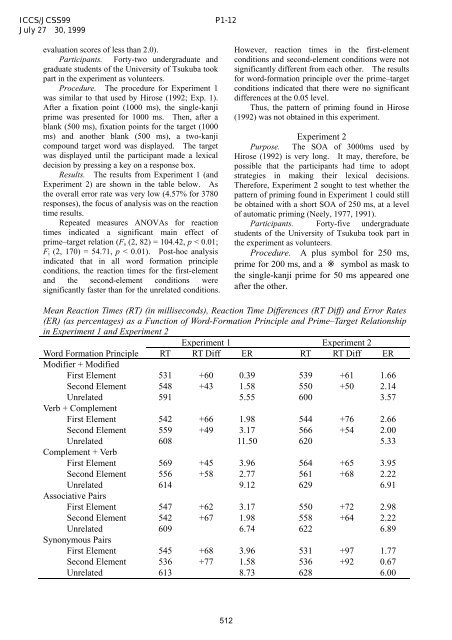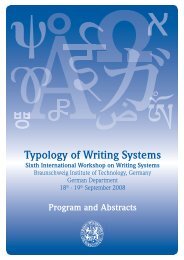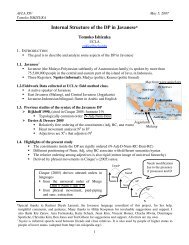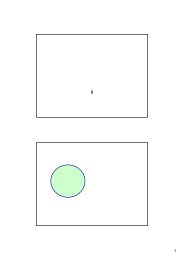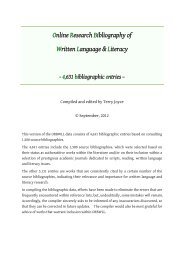A Priming Paradigm Study Terry Joyce, University of Tsukuba
A Priming Paradigm Study Terry Joyce, University of Tsukuba
A Priming Paradigm Study Terry Joyce, University of Tsukuba
Create successful ePaper yourself
Turn your PDF publications into a flip-book with our unique Google optimized e-Paper software.
ICCS/JCSS99 P1-12<br />
July 2730, 1999<br />
evaluation scores <strong>of</strong> less than 2.0).<br />
Participants. Forty-two undergraduate and<br />
graduate students <strong>of</strong> the <strong>University</strong> <strong>of</strong> <strong>Tsukuba</strong> took<br />
part in the experiment as volunteers.<br />
Procedure. The procedure for Experiment 1<br />
was similar to that used by Hirose (1992; Exp. 1).<br />
After a fixation point (1000 ms), the single-kanji<br />
prime was presented for 1000 ms. Then, after a<br />
blank (500 ms), fixation points for the target (1000<br />
ms) and another blank (500 ms), a two-kanji<br />
compound target word was displayed. The target<br />
was displayed until the participant made a lexical<br />
decision by pressing a key on a response box.<br />
Results. The results from Experiment 1 (and<br />
Experiment 2) are shown in the table below. As<br />
the overall error rate was very low (4.57% for 3780<br />
responses), the focus <strong>of</strong> analysis was on the reaction<br />
time results.<br />
Repeated measures ANOVAs for reaction<br />
times indicated a significant main effect <strong>of</strong><br />
prime–target relation (F s (2, 82) = 104.42, p < 0.01;<br />
F i (2, 170) = 54.71, p < 0.01). Post-hoc analysis<br />
indicated that in all word formation principle<br />
conditions, the reaction times for the first-element<br />
and the second-element conditions were<br />
significantly faster than for the unrelated conditions.<br />
However, reaction times in the first-element<br />
conditions and second-element conditions were not<br />
significantly different from each other. The results<br />
for word-formation principle over the prime–target<br />
conditions indicated that there were no significant<br />
differences at the 0.05 level.<br />
Thus, the pattern <strong>of</strong> priming found in Hirose<br />
(1992) was not obtained in this experiment.<br />
Experiment 2<br />
Purpose. The SOA <strong>of</strong> 3000ms used by<br />
Hirose (1992) is very long. It may, therefore, be<br />
possible that the participants had time to adopt<br />
strategies in making their lexical decisions.<br />
Therefore, Experiment 2 sought to test whether the<br />
pattern <strong>of</strong> priming found in Experiment 1 could still<br />
be obtained with a short SOA <strong>of</strong> 250 ms, at a level<br />
<strong>of</strong> automatic priming (Neely, 1977, 1991).<br />
Participants. Forty-five undergraduate<br />
students <strong>of</strong> the <strong>University</strong> <strong>of</strong> <strong>Tsukuba</strong> took part in<br />
the experiment as volunteers.<br />
Procedure. A plus symbol for 250 ms,<br />
prime for 200 ms, and a symbol as mask to<br />
the single-kanji prime for 50 ms appeared one<br />
after the other.<br />
Mean Reaction Times (RT) (in milliseconds), Reaction Time Differences (RT Diff) and Error Rates<br />
(ER) (as percentages) as a Function <strong>of</strong> Word-Formation Principle and Prime–Target Relationship<br />
in Experiment 1 and Experiment 2<br />
Experiment 1 Experiment 2<br />
Word Formation Principle RT RT Diff ER RT RT Diff ER<br />
Modifier + Modified<br />
First Element 531 +60 0.39 539 +61 1.66<br />
Second Element 548 +43 1.58 550 +50 2.14<br />
Unrelated 591 5.55 600 3.57<br />
Verb + Complement<br />
First Element 542 +66 1.98 544 +76 2.66<br />
Second Element 559 +49 3.17 566 +54 2.00<br />
Unrelated 608 11.50 620 5.33<br />
Complement + Verb<br />
First Element 569 +45 3.96 564 +65 3.95<br />
Second Element 556 +58 2.77 561 +68 2.22<br />
Unrelated 614 9.12 629 6.91<br />
Associative Pairs<br />
First Element 547 +62 3.17 550 +72 2.98<br />
Second Element 542 +67 1.98 558 +64 2.22<br />
Unrelated 609 6.74 622 6.89<br />
Synonymous Pairs<br />
First Element 545 +68 3.96 531 +97 1.77<br />
Second Element 536 +77 1.58 536 +92 0.67<br />
Unrelated 613 8.73 628 6.00<br />
512


